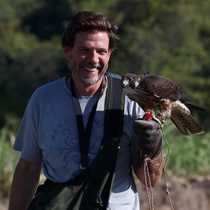San José Channel & Isla San Francisco
Blue whales, the largest animals that ever existed on the planet, Bryde’s whales and bottlenose dolphins greeted us during our first day sailing through the Gulf of California. Having almost disappeared from our oceans at the beginning of the twentieth century, it was truly amazing to be surrounded by three or more of these great leviathans all morning long. One of the reasons this is one of the best places to find such a great variety of marine mammals is that the Mexican waters of the gulf offer them protection, and a productive environment to sustain them.
At noon we anchored in the tranquil waters in Half Moon Bay on the west side of Isla San Francisco. We immediately recognized the dark patches in the otherwise clear blue waters of this protected bay as being great schools of flatiron herring. Another indicator was the presence of a large number of pelicans, Hermann’s gulls and yellow footed gulls. It added to our growing desire to jump in and explore these productive waters on our own from below. Our first day snorkeling offered up sightings of king angel fish, reef cornet fish, a number of brightly colored sea stars and schools of flat iron herring, among many other fish and invertebrates.
Isla San Francisco also provided us with our first opportunity to kayak and also explore an island in the Gulf of California by foot. A long hike led up to a steep ridge from which we had 360 degree views of all the surrounding islands, the very expansive sea and the colorfully stratified mainland. We also encountered our first cacti and learned of the different ways in which all desert life, both plants and animals, survive with little water and intense heat and sunlight. And finally we ended our trek through the desert tide pooling on the east side of the island. Sea cucumbers, brittle stars, crabs and other tiny invertebrates delighted our sense not only of sight, but also of touch.
Blue whales, the largest animals that ever existed on the planet, Bryde’s whales and bottlenose dolphins greeted us during our first day sailing through the Gulf of California. Having almost disappeared from our oceans at the beginning of the twentieth century, it was truly amazing to be surrounded by three or more of these great leviathans all morning long. One of the reasons this is one of the best places to find such a great variety of marine mammals is that the Mexican waters of the gulf offer them protection, and a productive environment to sustain them.
At noon we anchored in the tranquil waters in Half Moon Bay on the west side of Isla San Francisco. We immediately recognized the dark patches in the otherwise clear blue waters of this protected bay as being great schools of flatiron herring. Another indicator was the presence of a large number of pelicans, Hermann’s gulls and yellow footed gulls. It added to our growing desire to jump in and explore these productive waters on our own from below. Our first day snorkeling offered up sightings of king angel fish, reef cornet fish, a number of brightly colored sea stars and schools of flat iron herring, among many other fish and invertebrates.
Isla San Francisco also provided us with our first opportunity to kayak and also explore an island in the Gulf of California by foot. A long hike led up to a steep ridge from which we had 360 degree views of all the surrounding islands, the very expansive sea and the colorfully stratified mainland. We also encountered our first cacti and learned of the different ways in which all desert life, both plants and animals, survive with little water and intense heat and sunlight. And finally we ended our trek through the desert tide pooling on the east side of the island. Sea cucumbers, brittle stars, crabs and other tiny invertebrates delighted our sense not only of sight, but also of touch.



